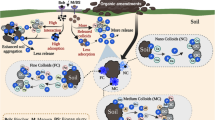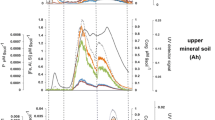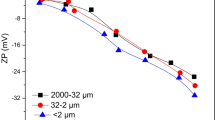Abstract
Citric acid exudation by plant roots is often linked to the mobilisation of recalcitrant soil phosphorus (P) for plant nutrition. In this case study, we have explored the effect of citric acid on the abundance, size and composition of water-dispersible soil colloids (WDC) to understand the mineral source of desorbed P and the chemical nature of P-carrying mobilized colloids. After incubation with citric acid, WDC were isolated using a soil particle-size fractionation method consisting of sedimentation, centrifugation and syringe filtration. The size range and composition of WDC was assessed using field-flow fractionation (FFF), combined with inductively coupled plasma mass spectrometry (ICP-MS) and UV spectrometry, for in vitro P desorption assay samples under the influence of increasing doses of citric acid. Three sharp and well-defined FFF particle size fractions of WDC containing P (12–23, 23–36 and 36–300 nm), with elution times matching carbon (C) peaks and offset from Fe, Al and Si fractions. The concentration of soluble or WDC-associated P, C, Fe, Al and Si increased in response to increasing citric acid doses. Silica colloids were only detected using syringe filtration below 5 µm. The Si, Fe and Al-containing fine colloid fractions (< 600 nm) were positively correlated with P (de)sorption parameters measured by diffusive gradient in thin films in previous work. The P desorbed by citric acid originated predominantly from the disaggregation of Fe and Al oxides and silicate clays. The citric acid effect on mobilizing organic P carrying WDC fractions may increase soil organic P cycling and availability to plants.



Similar content being viewed by others
Abbreviations
- P i :
-
Inorganic phosphorus
- P o :
-
Organic phosphorus measured as the difference between total and inorganic P
- DGT :
-
Diffusive gradients in thin films using a ferrihydrite containing gel as a P binding layer
- DET :
-
Diffusive equilibration in thin films (same DGT setup without the binding layer)
- DIFS :
-
“DGT-induced fluxes in soils and sediments” model
- P DET (mg l −1 ) :
-
Pore water (dissolved) P concentration determined using DET
- P DGT (mg l −1 ) :
-
DGT measured time averaged soil solution P concentration at the surface of DGT device
- P E :
-
Effective P concentration – DGT estimated soil solution P + labile P concentration from the solid phase.
- P Olsen (mg kg −1 ) :
-
Phosphorus concentration (solid phase) measured using NaHCO3 extraction
- k -1 (s −1 ) :
-
Desorption rate constant
- k 1 (s −1 ) :
-
Sorption rate constant
- K dl (cm 3 g −1 ) :
-
Equilibrium distribution coefficient between solid phase and soil solution
- R :
-
Ratio of PDGT to PDET
- R diff :
-
Ratio of PDGT to PE in the case where there is no P resupply from the solid phase, estimated using DIFS for diffusion only case
- T c (s) :
-
Response time of (de)sorption process
- WDC :
-
Water-dispersible colloids
- FFF :
-
Field-flow fractionation
- ICP-MS :
-
Inductively coupled plasma mass spectrometry
References
Almeida DS, Menezes-Blackburn D, Turner BL, Wearing C, Haygarth PM, Rosolem CA (2018a) Urochloa Ruziziensis Cover Crop Increases the Cycling of Soil Inositol Phosphates. Biol Fertil Soils 54:935–947
Almeida DS, Menezes-Blackburn D, Rocha KF, de Souza M, Zhang H, Haygarth P, Rosolem C (2018b) Can tropical grasses grown as cover crops improve soil phosphorus availability? Soil Use Manage 34:316–325
Barrow NJ, Debnath A, Sen A (2018) Mechanisms by which citric acid increases phosphate availability. Plant Soil 423:193–204. https://doi.org/10.1007/s11104-017-3490-8
Bol R, Gruau G, Mellander P-E, Dupas R, Bechmann M, Skarbøvik E, Bieroza M, Djodjic F, Glendell M, Jordan P (2018) Challenges of Reducing Phosphorus Based Water Eutrophication in the Agricultural Landscapes of Northwest Europe. Front Mar Sci 5:1–16
Clarholm M, Skyllberg U, Rosling A (2015) Organic acid induced release of nutrients from metal-stabilized soil organic matter -the unbutton model. Soil Biol Biochem 84:168–176
George TS, Giles CD, Menezes-Blackburn D, Condron LM, Gama-Rodrigues AC, Jaisi D, Lang F, Neal AL, Stutter MI, Almeida DS et al (2018) Organic phosphorus in the terrestrial environment: a perspective on the state of the art and future priorities. Plant Soil 427:191–208
Gerke J, Beißner L, Romer W (2000) The quantitative effect of chemical phosphate mobilization by carboxylate anions on P uptake by a single root. I The Basic Concept and Determination of Soil Parameters. J Plant Nutr Soil Sci 163:207–212
Giles CD, Richardson AE, Druschel GK, Hill JE (2012) Organic anion-driven solubilization of precipitated and sorbed phytate improves hydrolysis by phytases and bioavailability to Nicotiana tabacum. Soil Sci 177:591–598
Gimbert LJ, Andrew KN, Haygarth PM, Worsfold P (2003) Environmental applications of flow field-flow fractionation (FIFFF). Trends Anal Chem 22:615–633
Gottselig N, Nischwitz V, Meyn T, Amelung W, Bol R, Halle C, Vereecken H, Siemens J, Klumpp E (2017) Phosphorus binding to nanoparticles and colloids in forest stream waters. Vadose Zone J 16
Haygarth PM, Warwick MS, House WA (1997) Size distribution of colloidal molybdate reactive phosphorus in river waters and soil solution. Water Res 31:439–448
Hinsinger P (2001) Bioavailability of soil inorganic P in the rhizosphere as affected by root-induced chemical changes: a review. Plant Soil 237:173–195
Jiang X, Bol R, Nischwitz V, Siebers N, Willbold S, Vereecken H, Amelung W, Klumpp E (2015a) Phosphorus Containing Water Dispersible Nanoparticles in Arable Soil. J Environ Qual 44:1772–1781
Jiang X, Bol R, Willbold S, Vereecken H, Klumpp E (2015b) Speciation and distribution of P associated with Fe and Al oxides in aggregate-sized fraction of an arable soil. Biogeosci 12:6443–6452
Jiang X, Bol R, Cade-Menun BJ, Nischwitz V, Willbold S, Bauke SL, Vereecken H, Amelung W, Klumpp E (2017) Colloid-bound and dissolved phosphorus species in topsoil water extracts along a grassland transect from Cambisol to Stagnosol. Biogeosci 14:1153–1164
Jones DL (1998) Organic acids in the rhizosphere - a critical review. Plant Soil 205:25–44
Konrad A, Billiy B, Regenbogen P, Bol R, Lang F, Klumpp E, Siemens J (2021) Forest soil colloids enhance delivery of phosphorus into a diffusive gradient in thin films (DGT) Sink. Front For Global Change 3
Krause L, Klumpp E, Nofz I, Missong A, Amelung W, Siebers N (2020) Colloidal iron and organic carbon control soil aggregate formation and stability in arable Luvisols. Geoderma 374:114421
Liu J, Yang J, Liang X, Zhao Y, Cade-Menun BJ, Hu Y (2014) Molecular speciation of phosphorus present in readily dispersible colloids from agricultural soils. Soil Sci Soc Am J 78:47–53
Lopez-Bucio J, de la Vega OM, Guevara-Garcia A, Herrera-Estrella L (2000) Enhanced Phosphorus Uptake in Transgenic Tobacco Plants That Overproduce Citrate. Nature Biotechnol 18:450–453
Mason S, McNeill A, McLaughlin MJ, Zhang H (2010) Prediction of wheat response to an application of phosphorus under field conditions using diffusive gradients in thin-films (DGT) and extraction methods. Plant Soil 337:243–258
Menezes-Blackburn D, Jorquera MA, Greiner R, Gianfreda L, de la Luz MM (2013) Phytases and phytase-labile organic phosphorus in manures and soils. Crit Rev Environ Sci Technol 43:916–954
Menezes-Blackburn D, Paredes C, Zhang H, Giles CD, Darch T, Stutter M, George TS, Shand C, Lumsdon D, Cooper P (2016a) Organic acids regulation of chemical–microbial phosphorus transformations in soils. Environ Sci Technol 50:11521–11531
Menezes-Blackburn D, Zhang H, Stutter M, Giles CD, Darch T, George TS, Shand C, Lumsdon D, Blackwell M, Wearing C (2016b) A Holistic Approach to Understanding the Desorption of Phosphorus in Soils. Environ Sci Technol 50:3371–3381
Menezes-Blackburn D, Giles C, Darch T, George TS, Blackwell M, Stutter M, Shand C, Lumsdon D, Cooper P, Wendler R (2018) Opportunities for mobilizing recalcitrant phosphorus from agricultural soils: a review. Plant Soil 427:5–16
Missong A, Bol R, Willbold S, Siemens J, Klumpp E (2016) Phosphorus forms in forest soil colloids as revealed by liquid-state 31P-NMR. J Plant Nutr Soil Sci 179:159–167
Missong A, Holzmann S, Bol R, Nischwitz V, Puhlmann H, Wilpert KV, Siemens J, Klumpp E (2018) Leaching of natural colloids from forest topsoils and their relevance for phosphorus mobility. Sci Total Environ 634:305–315
Nischwitz V, Gottselig N, Missong A, Meyn T, Klumpp E (2016) Field flow fractionation online with ICP-MS as novel approach for the quantification of fine particulate carbon in stream water samples and soil extracts. J Anal at Spectrom 31:1858–1868
Richardson AE, Hocking PJ, Simpson RJ, George TS (2009) Plant Mechanisms to Optimize Access to Soil Phosphorus. Crop Pasture Sci 60:124–143
Rosas A, Pinilla L, Menezes-Blackburn D, Mora ML (2008) Exudation of Organic Acids in Ryegrass and White Clover in Response to Different Phosphorous and Manganese Doses. J Soil Sci Plant Nutr 8:233–234
Ryan PR, James RA, Weligama C, Delhaize E, Rattey A, Lewis DC, Bovill WD, McDonald G, Rathjen TM, Wang E (2014) Can citrate efflux from roots improve phosphorus uptake by plants? Testing the Hypothesis with near-Isogenic Lines of Wheat. Physiol Plant 151:230–242
Shinohara S, Eom N, Teh E-J, Tamada K, Parsons D, Craig VS (2018) The Role of citric acid in the stabilization of nanoparticles and colloidal particles in the environment: measurement of surface forces between hafnium oxide surfaces in the presence of citric acid. Langmuir 34:2595–2605
Six L, Smolders E, Merckx R (2013) The performance of DGT versus conventional soil phosphorus tests in tropical soils—maize and rice responses to P application. Plant Soil 366:49–66
Syers J, Johnston A, Curtin D (2008) Efficiency of soil and fertilizer phosphorus use. Reconciling changing concepts of soil phosphorus behaviour with agronomic information. FAO Fertilizer and Plant Nutrition Bulletin 18 Food and Agriculture Organization of the United Nations, Rome
Tovkach A, Ryan PR, Richardson AE, Lewis DC, Rathjen TM, Ramesh S, Tyerman SD, Delhaize E (2013) Transposon-mediated alteration of TaMATE1B expression in wheat confers constitutive citrate efflux from root apices. Plant Physiol 161:880–892
Vance CP, Uhde-Stone C, Allan DL (2003) Phosphorus acquisition and use: critical adaptations by plants for securing a nonrenewable resource. New Phytol 157:423–447
Wang Y, Chen X, Whalen JK, Cao Y, Quan Z, Lu C, Shi Y (2015) Kinetics of inorganic and organic phosphorus release influenced by low molecular weight organic acids in calcareous, neutral and acidic soils. J Plant Nutr Soil Sci 178:555–566
Wang L, Missong A, Amelung W, Willbold S, Prietzel J, Klumpp E (2020) Dissolved and colloidal phosphorus affect P cycling in calcareous forest soils. Geoderma 375:114507
Wei L, Chen C, Xu Z (2010) Citric Acid Enhances the Mobilization of Organic Phosphorus in Subtropical and Tropical Forest Soils. Biol Fert Soils 46:765–769
Funding
This work was performed with financial support of the Organic Phosphorus Utilisation in Soils (OPUS) project, funded by Biotechnology and Biological Sciences Research Council (BBSRC) responsive mode grant (BB/K018167/1) in the UK to explore cropping strategies to target the use of recalcitrant soil Po. We thank the OPUS team for the important work leading to this manuscript, especially Prof. Hao Zhang, Dr. Courtney D. Giles, Dr. Tegan Darch, Dr. Marc Stutter, Dr. Timothy S. George, Dr. Charles Shand, Dr. David Lumsdon, Patricia Cooper, Renate Wendler, Dr. Lawrie Brown, Dr. Martin Blackwell and Dr. Catherine Wearing. The first author received financial support from Sultan Qaboos University through the projects RF/AGR/SWAE/18/01 and IG/AGR/SWAE/19/02, as well as the Alexander von Humboldt Foundation through a renewed research stay fellowship. The authors appreciate the additional in-kind support from SQU, Oman.
Author information
Authors and Affiliations
Corresponding author
Ethics declarations
Conflict of Interest
The authors declare no competing interests.
Additional information
Publisher's Note
Springer Nature remains neutral with regard to jurisdictional claims in published maps and institutional affiliations.
Supplementary Information
Below is the link to the electronic supplementary material.
Rights and permissions
About this article
Cite this article
Menezes-Blackburn, D., Bol, R., Klumpp, E. et al. Citric Acid Effect on the Abundance, Size and Composition of Water-Dispersible Soil Colloids and Its Relationship to Soil Phosphorus Desorption: A Case Study. J Soil Sci Plant Nutr 21, 2436–2446 (2021). https://doi.org/10.1007/s42729-021-00534-9
Received:
Accepted:
Published:
Issue Date:
DOI: https://doi.org/10.1007/s42729-021-00534-9




